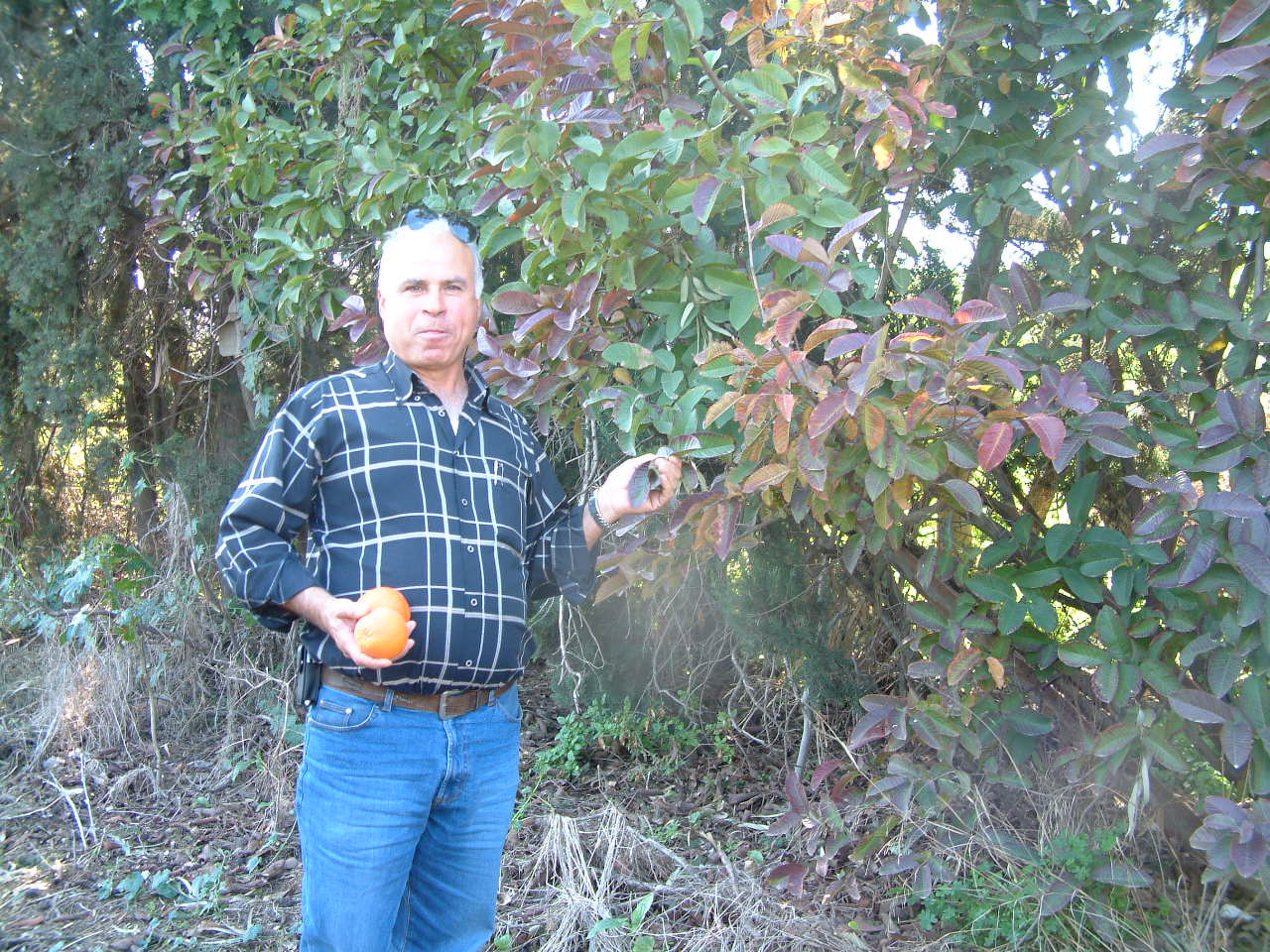
There were 600 people in the village. Atta was one of the wealthiest people in Palestine, until today he has hundreds of dunams in the Ramat Hasharon area. Today he lives in Qalqilya. Atta was an orchard keeper, and from here they took the water for irrigation. My uncle on my mother’s side lived where the air force headquarters are today, east of Cinema City. His name was Jamil al-Jasser. He is married to a Jewish woman from Herzliya and they live in Amman. His wife became anti-Jewish, doesn’t like Jews.
Let’s go to my family’s water well and to our orchard. The structure of the well was restored and painted only two or three months ago.
I was born in 1943 and I don’t remember a thing from here. My uncle was the mukhtar [head] of the village, and he came from Nablus to see the place in 1967, after the occupation of the West Bank. His name is Mohammed Hajj Yichieh Abu Sneineh. He came dressed in traditional Arab clothes, arrived at the place and started to cry with emotion. He saw that here was the well, here was a water pit, and he came to the house where he had lived until 1948. He asked permission to enter, and there was a woman who lived there, who didn’t know who he was, of course. Her Hebrew was kind of weak. But in any case she was able to say to him, “You need to help us renovate the house.” She didn’t know it was his house, she was naive.
Only my family and my aunt’s family remain in the country. We live on the border of Kfar Saba, near Neve Yemin, not far from Qalqilya. My family had a lot of land, in Ijlil and also where we live today. When they threw us out we stayed to live there. We built houses there and we stayed in the state.
The village made a living from orchards, and also from growing strawberries. They sold a lot to Jaffa. Today the lands belong to Kibbutz Glil Yam and to the Israel Lands Authority. Every few years the ownership of the land changed. In the beginning it was the Development Authority, later the Israel Lands Authority, so that it would be difficult to claim the lands back in court. In the 1950s we took a Jewish attorney named Negbi. He made an effort for us to get something. All the state offered was 500 liras per dunam and we did not agree to it, because what are 500 liras for such valuable land? Our mistake was that we didn’t agree to take other lands in exchange, because then we could have established a large village in place of Neve Yemin. No one from the village agreed to take money or land in exchange for the land. Today there is no one left to sue. It’s a null debt. Today we can’t get anything back for it, even if we wanted to.
In 1948 a family called Shubaki lived where Neve Amal in Herzliya in today. They have houses there until today. They lived not as a whole village, but just the family. The Arabs lived that way then, scattered, because there was a lot of space. The Hagana came and told them to get out. They said “Okay,” entered the orchards to hide, and later they returned to their homes. The following day the Hagana came back and again told them to leave. The Arabs went but again they returned. A few days later, they stood them on the road that connected between Herzliya and Ra’anana, which was then a gravel road, and there in the junction they killed six of them: cousins, a son, and their father. The Arabs in the area were also questioned and they went into a panic from that story. They exaggerated the story and said that they killed the whole family, “They killed Shuabaka,” meaning they killed the whole family. Today one of the family members is embroiled in the Karin A weapons ship matter. One of them, Shubaki, is the youngest son of the family that was killed not far from here. Today he is imprisoned in the Palestinian Authority. In Ijlil they heard the story and ran away. Those who could took something with them and the others simply fled immediately.
At one time there was a very high gravel hill where Cinema City and the Rav Mecher is today. They took the gravel for construction. I had a truck for transporting construction material and in 1967 I bought gravel here from our land for 19.5 liras. The man who sold it knew my father. Our house was on that hill until 1967. It was a beautiful 3-story house. My father and my uncle lived there. And here is our water well that exists until today, and only recently they restored and painted its structure. Here beside the water well was my family’s house. Every farmer had his own well. In Ijlil there were 15 wells. The well was inside a structure, which remains whole since then, to protect it from dirt. Until today this well provides water here with a new pump.
In the 1950s there were no cars, and I would come here with my father on a carriage from Kfar Saba. My father would cry, and I wouldn’t understand why. I asked him why he was crying, and every time he would tell me the same story that he had dust in his eye, things like that. He wouldn’t tell me about what happened in 1948. In the orchard we had a few mandelaine trees, which is something like a tangerine, which grew well in the sandy soil here. We would pick them and I would fill my shirt with some 20 mandelaines, and my father would start to eat them. Eat and throw everything away enthusiastically. “Bring me another two to eat,” he said, but I told him that I was saving those for mother. When I grew up, I understood why he didn’t want to take them to my mother. So as not to hurt her, so she wouldn’t start to cry. This pine tree here is from then.
Later when I grew up my father told me how they left, who was in favor and who was opposed, who was guilty and who wasn’t. We were a very well-known family here in Herzliya and Ramat Hasharon, which are close by. Even today, the fourth and fifth generations, we are their friends and keep in touch. They told my father, “Don’t go out, Sabri, don’t go out from here. Come sleep at our house.” My father gave the house keys to someone named Moshe Ramati, who was like a guard here in the area. After the war he became big in the army. Moshe Ramati is one of the major landowners here in Ramat Hasharon. I don’t know what kind of deals he made, but he was able to buy himself a lot of land. How he cheated or didn’t cheat I wouldn’t know, I’m just a little guy in those things. This Ramati was a good friend of my family then, and worked for the Development Authority. He was a captain, and in the first years of the state he was the military governor of the Triangle area. Thanks to him we were able to stay in the country, near Neve Yemin, until today. Because back then people would come from the army in these kind of ancient Jeeps, and say, “No one can stay here.” They didn’t drive out whole villages, but the twenty or thirty people they would find here, and it was easy to drive them out eastward. They would tell them, “Yalla ruh min hon! Ruh min hon!” [Come on get out of here! Get out of here!”] to Jordan or to Gaza. But a whole village, say a thousand people, they couldn’t throw out. Like Tira, like Jaljuliya, they couldn’t throw out. They tried but they didn’t succeed.
One day my father passed by the road between Jaljuliya and Neve Yemin, and suddenly he saw a military jeep stop beside him. Who was it? Moshe Ramati from Ramat Hasharon. They hugged and cried, both of them, and he asked him, “Sabri, where do you live?” He said, “I live here in the orchard.” It was true, we lived a good number of days in the orchards, because my father said, “I will die and not leave Palestine.” He didn’t want to go to any other place, he was a little more aware than other people. He said, “Here at least I have a home, there I have nothing.” And he stayed and got a letter from Ramati permitting him to stay there. When they came from the army and yelled at him, “What are you doing here?” he showed them the letter, and they let him stay on our lands near Neve Yemin. Because of the Shubaki story people fled Sidna Ali, Ijlil, Sheikh Muwannis, Sawalima. You couldn’t find anyone in this whole area in two minutes. There was one Bedouin man who stayed who worked for us. Later he said that it was his and he wouldn’t leave, so he got compensation money, I heard he got two million shekels.
The Abu Sneinehs had a lot of orchards and also guava, which they sold all the way to Lebanon. Prices were good then. My father bought lands in 1942 or 1945. When he had money he would buy land there in the area of Neve Yemin. In Tulkarem we also have land. So in 1948 we moved to our lands in the area of Neve Yemin. Today we are a kind of unrecognized village. We are considered residents of Kfar Saba, but only for taxes and nothing else. I don’t get electricity from Kfar Saba, my water is private, we have our own wells. My father had three wells. Two here in Ijlil, and another that exists over there until today, where we live. Sewage – nothing. I wish they would give us recognition as a separate village. We are fourteen families there, the families of Abu Sabri and Abu Sneineh. We are right next to Road 6, near the wall, close to Qalqilya. We are about seventy people there. Originally a father and five sons.
This is the place we left from, father, mother, grandmother, five sons and a daughter. We left from here in a carriage. It was a beautiful house in its time. We know families from Ramat Hasharon, until today we are in touch with them – Telmor, Binyamini. I don’t remember the exact date we left from here. The same day that Sidna Ali, Sheikh Muwannis, and Ijlil left. It helped that we thought we would return in two weeks.
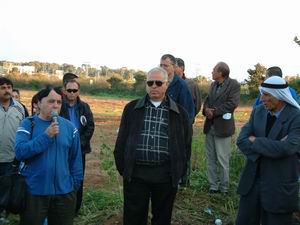
Ijlil Tour 2004 (10)
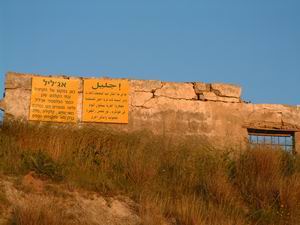
Ijlil Tour 2004 (15)
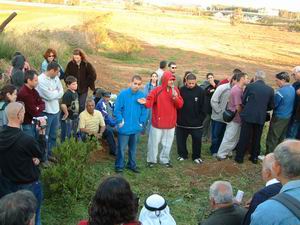
Ijlil Tour 2004 (12)
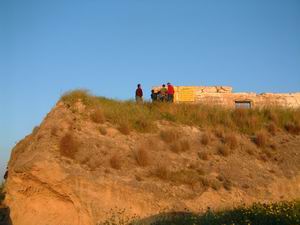
Ijlil Tour 2004 (13)
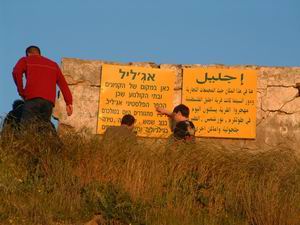
Ijlil Tour 2004 (14)
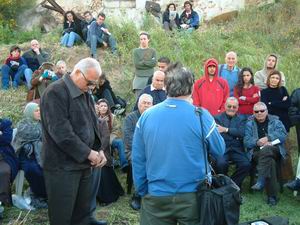
Ijlil Tour 2004 (11)
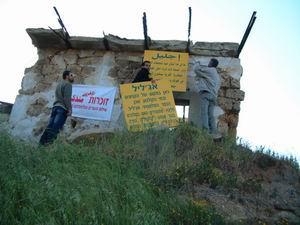
Ijlil Tour 2004 (4)
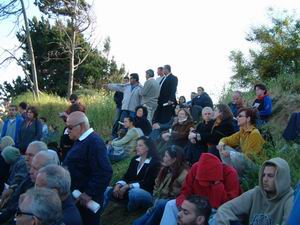
Ijlil Tour 2004 (3)
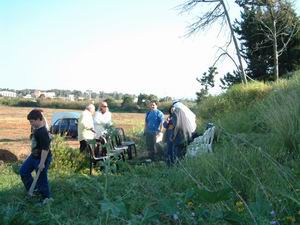
Ijlil Tour 2004
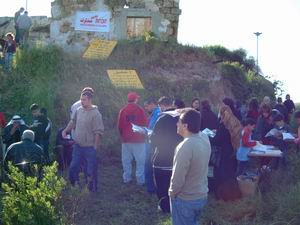
Ijlil Tour 2004 (1)

